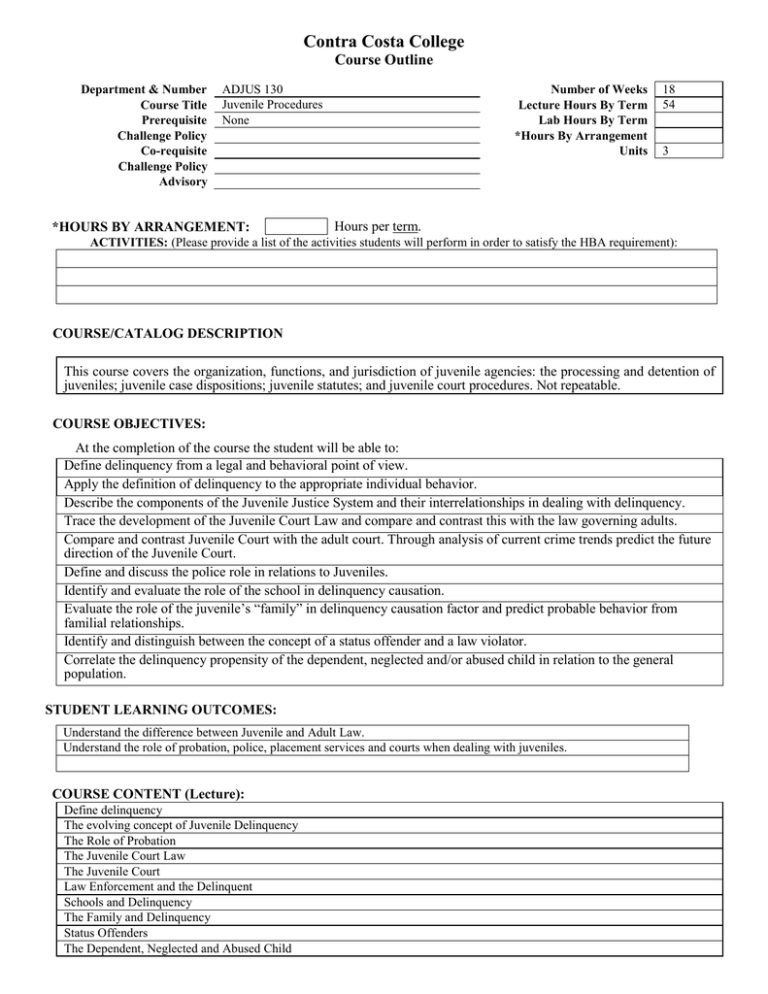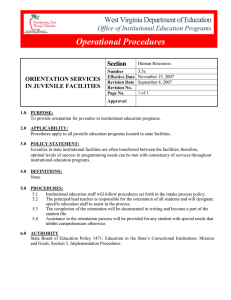ADJUS 130-F13.doc 81KB Apr 02 2014 01:49:25 PM
advertisement

Contra Costa College Course Outline Department & Number Course Title Prerequisite Challenge Policy Co-requisite Challenge Policy Advisory ADJUS 130 Juvenile Procedures None *HOURS BY ARRANGEMENT: Number of Weeks Lecture Hours By Term Lab Hours By Term *Hours By Arrangement Units 18 54 3 Hours per term. ACTIVITIES: (Please provide a list of the activities students will perform in order to satisfy the HBA requirement): COURSE/CATALOG DESCRIPTION This course covers the organization, functions, and jurisdiction of juvenile agencies: the processing and detention of juveniles; juvenile case dispositions; juvenile statutes; and juvenile court procedures. Not repeatable. COURSE OBJECTIVES: At the completion of the course the student will be able to: Define delinquency from a legal and behavioral point of view. Apply the definition of delinquency to the appropriate individual behavior. Describe the components of the Juvenile Justice System and their interrelationships in dealing with delinquency. Trace the development of the Juvenile Court Law and compare and contrast this with the law governing adults. Compare and contrast Juvenile Court with the adult court. Through analysis of current crime trends predict the future direction of the Juvenile Court. Define and discuss the police role in relations to Juveniles. Identify and evaluate the role of the school in delinquency causation. Evaluate the role of the juvenile’s “family” in delinquency causation factor and predict probable behavior from familial relationships. Identify and distinguish between the concept of a status offender and a law violator. Correlate the delinquency propensity of the dependent, neglected and/or abused child in relation to the general population. STUDENT LEARNING OUTCOMES: Understand the difference between Juvenile and Adult Law. Understand the role of probation, police, placement services and courts when dealing with juveniles. COURSE CONTENT (Lecture): Define delinquency The evolving concept of Juvenile Delinquency The Role of Probation The Juvenile Court Law The Juvenile Court Law Enforcement and the Delinquent Schools and Delinquency The Family and Delinquency Status Offenders The Dependent, Neglected and Abused Child COURSE CONTENT (Lab): METHODS OF INSTRUCTION: Lecture (Live or Online) Video/ Discovery exercises Learning exercises Field Trips Guest speakers INSTRUCTIONAL MATERIALS: NOTE: To be UC/CSU transferable, the text must be dated within the last 7 years OR a statement of justification for a text beyond the last 7 years must be included. Textbook Title: Author: Publisher: Edition/Date: Textbook Reading Level: Justification Statement: Juvenile Justice Elrod and Ryder Jones and Bartlet 4th/ 2013 13 OUTSIDE OF CLASS WEEKLY ASSIGNMENTS: Title 5, section 55002.5 establishes that a range of 48 -54hours of lecture, study, or lab work is required for one unit of credit. For each hour of lecture, students should be required to spend an additional two hours of study outside of class to earn one unit of credit. State mandates that sample assignments must be included on the Course Outline of Record. Outside of Class Weekly Assignments Hours per week Weekly Reading Assignments (Include detailed assignment below, if applicable) 3 Students will complete weekly reading assignments and review questions and quiz. Weekly Writing Assignments (Include detailed assignment below, if applicable) 2 Student will prepare case studies and a research paper from the readings on a weekly basis and distinguish how juvenile procedures are different then adult procedures. Students will also create a notebook as a study guide for the midterm and final exams. Weekly Math Problems (Include detailed assignment below, if applicable) Lab or Software Application Assignments (Include detailed assignment below, if applicable) Other Performance Assignments (Include detailed assignment below, if applicable) Students will participate in online discussion led by the instructor weekly STUDENT EVALUATION: (Show percentage breakdown for evaluation instruments) 20 20 50 % % % Case studies Research paper Testing 1 10 % Discussions GRADING POLICY: (Choose LG, P/NP, or SC) Pass / No Pass x Letter Grade 90% - 100% = A 80% - 89% = B 70% - 79% = C 60% - 69% = D Below 60% = F Prepared by: R. Ramos Date: 11/5/13 Revised form 10/13 70% and above = Pass Below 70% = No Pass Student Choice 90% - 100% = A 80% - 89% = B 70% - 79% = C 60% - 69% = D Below 60% = F or 70% and above = Pass Below 70% = No Pass

